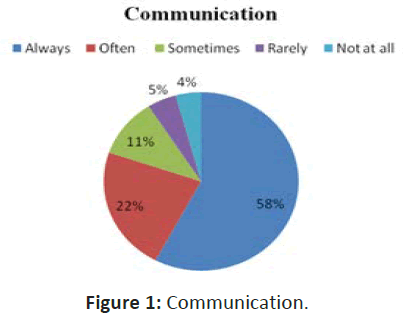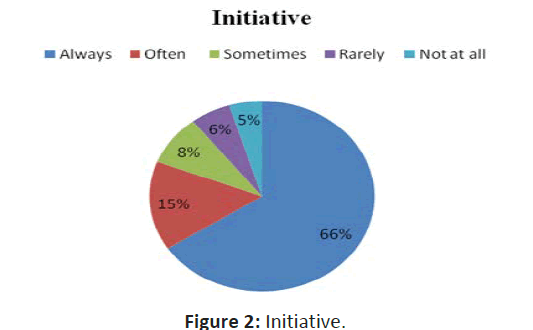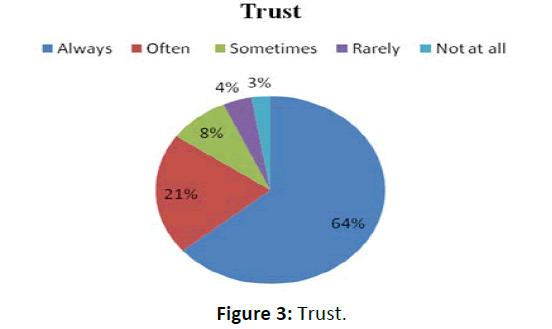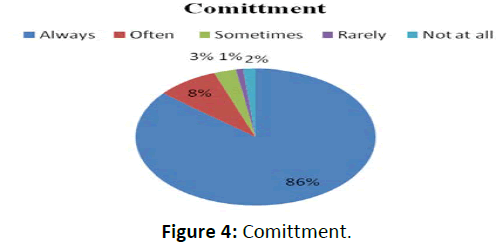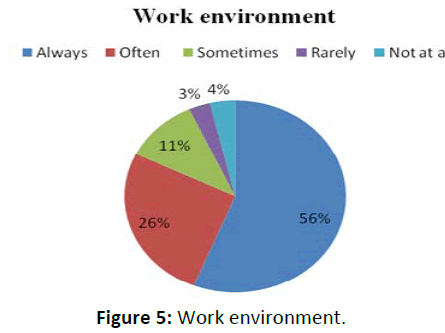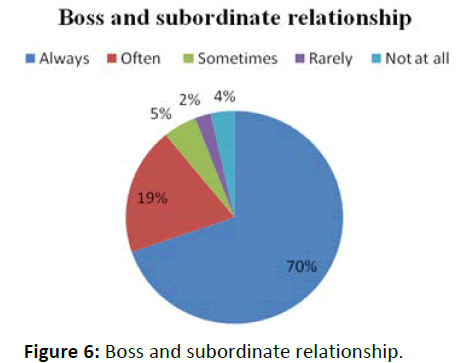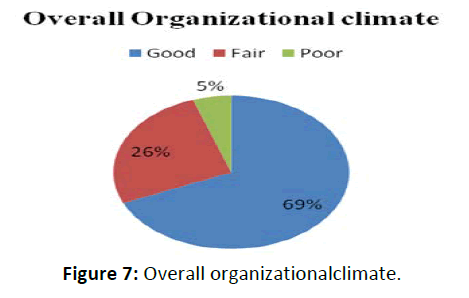A Study on Organizational Climate Survey
Shailendra Patil* , Pravin Jadhav and Vinay Patil
Department of Management Studies, DKTE'S Textile and Engineering Institute, Maharashtra, India
Published Date: 2022-06-15Shailendra Patil*, Pravin Jadhav and Vinay Patil
Department of Management Studies, DKTE'S Textile and Engineering Institute, Maharashtra, India
- *Corresponding Author:
- Shailendra Patil
Department of Management Studies,
DKTE'S Textile and Engineering Institute, Maharashtra,
India,
Tel: 9028258954
E-mail:srpmba@dkte.ac.in
Received date: April 08, 2022, Manuscript No. IPJHMM-22-13059; Editor assigned date: April 11, 2022, PreQC No. IPJHMM-22-13059 (PQ); Reviewed date: April 25, 2022, QC No. IPJHMM-22-13059; Revised date: June 07, 2022, Manuscript No. IPJHMM-22-13059 (R); Published date: June 15, 2022, DOI: 10.36648/2471-9781.8.9.332
Citation: Patil S, Jadhav P, Patil V (2022) A Study on Organizational Climate Survey. J Hosp Med Manage Vol:8 No:9.
Abstract
This study investigated the organizational climate survey and its effects on organizational variables. The purpose of this study is to present research on the importance of requisitely holistically selected organizational climate survey and to determine their impact on work engagement of employees in the organizations. The quantitative research is based on the implementation of an exploratory factor analysis.
Investigation of 152 employees indicated the parameters like communication, initiative, trust, commitment, superior and subordinate relationship and work environment are the main investigative factors of organizational climate and these factors have been considered in the present study.
The study would be very useful to the management of organization and also to human recourse department; to understand various issues pertaining to organizational climate within an organization. Based on the research results, we confirmed that organizational climate critical issues, various indicators, organizational values, employee satisfaction and employee motivation have a significant positive impact on work engagement of employees the organizations.
Keywords
Organizational climate; Work environment; Management of organization; Employee satisfaction
Introduction
Organizational climate refers to a complex set of forces within an organization, which have a direct influence on those who work in it. Studying organizational climate is imperative to understanding how organizations function at their core [1].
Organizational climate is an internal quality that is unique and peculiar to an organization. Organizational climate has been defined as the way in which organizational members perceive and characterize their environment in an attitudinal and value- based manner. It is a set of attributes specific to a particular organization that may be induced from the way the organization deals with its members and its environment. In generalized term, organizational climate can be seen as social and psychological environment or atmosphere that characterizes a particular organization. The organizational climate comprises of the shared perceptions about organizational norms, values, beliefs, practices and procedures that can be observed at general or specific levels.
Organizational climate is one of the most important matters regarding organizational environment, which has a direct relationship with employee behavior. Organizational climate as the way in which employees perceive their organization and its purposes.
Organizational climate has a significant impact on the well-being of employees that has a direct influence on quality and quantity of work done in the organization. There are various studies regarding the relationship between organizational climate and its consequences. The concepts like job satisfaction need for achievement, affiliation and power, overall organizational effectiveness and individual performance are found to be the dependent variables and consequences of organizational climate [2-4].
Objectives of the study
• To identify hidden critical issues of organizational climate.
• To assess the organizational climate on the basis of various indicators
• To study impact of organizational climate on employee engagement of employees [5].
Importance of the study
• The study would be helpful to know exiting climate of the organization.
• The study would be helpful to HR department of an organization to understand present climate of various departments which would enable the HR department to focus on issues influencing the climate of respective department [6,7].
• The study would be helpful to find out hidden critical issues in the organizational climate and also it will help to find out type of organizational climate.
• The present study would help HR department to implement HR strategies to improve of the organization.
Literature Review
In the study it is addressed the parameters like communication, initiative, trust, commitment, superior and subordinate relationship and work environment. In this the opinions from various departments have been taken and for the same we got various references from so many articles [8].
The concept of organizational commitment was first defined by Becker based on the premise that organizational commitment is built on the principle of consistent behavior. In literature, commitment is described in terms of degree of goal or value congruency with the organization.
Helsel and Herbert examined the perceptions of organizational climate which were hypothesized to be related to their expectations that successful change would occur in the organisation. Successful change was defined as the extent to which the probability of desirable change exceeds that of undesirable change. Correlations were computed between perceived climate, and six dimensions of climate on the one hand, and expectations for successful change on the other [9-11].
A study by Sora showed that the organization climate of insecurity served as stress to employees. The results suggested that a climate of job insecurity influenced employee’s job satisfaction and organization commitment maintains a positive relationship between departmental, and organization climate will lead to increased job satisfaction, commitment, performance.
Noordin, as competitiveness had new heights, it is important that human resource practitioners strive to create a positive organizational climate that promotes commitment to and from the organization by ensuring that the employee’s perceptions remain positive [12].
Furlich outlined an organization should aim at enhancing the three levels of management, to enhance full motivation among the employees.
Kassem and Gaber identified factors of organizational climate like partial rewards, lack of leadership, poor decision making, consistently hiring in experienced people which will lead to job satisfaction.
Saeidipou conducted a survey on three hundred employees had shown a reciprocal relationship between the components of organizational climate just as organizational roles, goals, rewards, practices, communication with organizational commitment resulting into below performance by the staff nurses if prevails an unfavorable organizational climate.
Reynolds the purpose of the study was to explore perceptions of organizational climate at their industry, job. The final aim of the study was to use logistic regression to identify the determinants of job satisfaction [13].
Rekha Nair in her study noted the increasing importance of workplace climate on employee job satisfaction, creativity, motivation and retention. Because of the importance of workplace climate, IBM made adjustments and set best practices which in turn have helped the organization to stay on top. In between organizational climate and company performance, employee plays an important role because employee’s job satisfaction is highlighted as the mediator between organizational climate and company performance. Literature on organizational climate and its impact on firm’s overall performance is many but the recent studies of Ostroff and Bowen proposed that organizational climate is a bridge that links HRM and performance.
Organizational climate have been proven to influence employee’s behavior such as participation, absenteeism level of stress and work commitment.
Research methodology and data analysis
Type of research: Quantitative research [14].
Primary data: The questionnaire based on the above stated objectives was prepared in order to have the first hand information from the work environment of the company. The questionnaire was prepared for both staff members and workers. Again the observation method was used to collect data during 50 days of project work.
Secondary data: The secondary data was collected from the web site of the company, reference from earlier research reports related to this topic, etc.
Sample design and sample size: Sampling Frame includes employees and Sampling Method is Random Sample.
The data is analyzed at three levels as overall organizational level, departmental level and on the basis of parameters [15].
Climate measures
Six types of climates were studied as independent variables in the current study.
Communication climate
Overall communication climate was accessed with five item measures. All of them had a 5-point Likert type Scale with anchors as always, often, sometimes, rarely, not at all. This climate was studied by asking the following facts:
• You are satisfied with the communication method followed in your organization.
• Most of the notices are informed to you as a grapevine rather than through paper channels.
• The person to whom you report practices open communication [16].
Trust climate
Overall trust climate was accessed with five item measures. All of them had a 5-point Likert type Scale with anchors as always, often, sometimes, rarely, not at all. This climate was studied by asking the following facts:
• I have trust on management for bright future of organization.
• Management has a good understanding of what goes on in the organization.
• You feel proud while working in the organization and Management takes employee suggestions seriously [17].
Initiative climate
Overall Initiative climate was accessed with six item measures. All of them had a 5-point Likert type scale with anchors as always, often, sometimes, rarely, not at all. This climate was studied by asking the following facts:
• I take initiative in problem solving at shop floor. I do complain about nonperformer to my seniors [18].
• I contribute and take efforts in the growth of the organization.
• I take initiative to put my idea forward for the betterment of the organization.
• I take initiative to take responsibilities offered to me.
Commitment climate
Overall commitment climate was accessed with four item measures [19]. All of them had a 5-point Likert type scale with anchors as always, often, sometimes, rarely, not at all. This climate was studied by asking the following facts:
• I am willing to work as hard as necessary to get the job done and willing to put in extra effort when necessary.
• I plan to spend my entire career at my company [20].
Work climate
Overall work climate was accessed with six item measures. All of them had a 5-point Likert type scale with anchors as always, often, sometimes, rarely, not at all. This climate was studied by asking the following facts:
• You are comfortable with the amount of time you spent with work [21].
• You have health awareness programs in your organization.
• Working conditions in my environment are continually improving.
• My work environment is healthy [22].
Boss and subordinate relationship’s climate
Overall climate showing relationship between boss and subordinate was accessed with five item measures. All of them had a 5-point Likert type scale with anchors as always, often, sometimes, rarely, not at all. This climate was studied by asking the following facts:
• Your supervisors are friendly with you and they support your ideas for improvement.
• They care about your job satisfaction.
• All members of your group are treated fairly by evenly distributing the workload.
• They support change and innovation.
After taking the opinion about Organizational climate by respondents from various departments in the organization following Tables 1-7, Figures 1-7 are formulated for final research objectives [23].
| Communication | Ratings | |||||
|---|---|---|---|---|---|---|
| Always good |
Often | Sometimes | Rarely | Not at all | Total | |
| No. of responses | 439 | 171 | 81 | 37 | 32 | 760 |
| No. of respondents | 152 | 152 | 152 | 152 | 152 | |
| Average/Mean response | 2.89 | 1.13 | 0.53 | 0.24 | 0.21 | 5 |
| Percentage (%) | 57.76 | 22.50 | 10.66 | 4.87 | 4.21 | 100.00 |
Table 1: Extent to which respondents favor 'communication' pattern in an organization.
| Initiative | Ratings | |||||
|---|---|---|---|---|---|---|
| Always | Often | Sometimes | Rarely | Not at all | Total | |
| No. of responses | 600 | 138 | 78 | 53 | 43 | 912 |
| No. of respondents | 152 | 152 | 152 | 152 | 152 | |
| Average/Mean response | 3.95 | 0.91 | 0.51 | 0.35 | 0.28 | 6.00 |
| Percentage (%) | 65.79 | 15.13 | 8.55 | 5.81 | 4.71 | 100 |
Table 2: Extent to which their 'Initiation' is entertained in an organization.
| Trust | Ratings | ||||||
|---|---|---|---|---|---|---|---|
| Always | Often | Sometimes | Rarely | Not at all | Total | ||
| No. of responses | 485 | 159 | 65 | 31 | 20 | 760 | |
| No. of respondents | 152 | 152 | 152 | 152 | 152 | ||
| Average/Mean response | 3.19 | 1.05 | 0.43 | 0.20 | 0.13 | 5.00 | |
| Percentage (%) | 63.82 | 20.92 | 8.55 | 4.08 | 2.63 | 100.00 | |
Table 3: Extent to which an organization is 'Trustworthy'.
| Commitment | Ratings | ||||||
|---|---|---|---|---|---|---|---|
| Always | Often | Sometimes | Rarely | Not at all | Total | ||
| No. of responses | 523 | 51 | 18 | 6 | 10 | 608 | |
| No. of respondents | 152 | 152 | 152 | 152 | 152 | ||
| Average/Mean response | 3.44 | 0.34 | 0.12 | 0.04 | 0.07 | 4.00 | |
| Percentage (%) | 86.02 | 8.39 | 2.96 | 0.99 | 1.64 | 100.00 | |
Table 4: Extent of 'commitment' in organization.
| Work Environment | Ratings | ||||||
|---|---|---|---|---|---|---|---|
| Always good |
Often | Sometimes | Rarely | Not at all | Total | ||
| No. of responses | 427 | 198 | 83 | 24 | 28 | 760 | |
| No. of respondents | 152 | 152 | 152 | 152 | 152 | ||
| Average/Mean response | 2.81 | 1.30 | 0.55 | 0.16 | 0.18 | 5.00 | |
| Percentage (%) | 56.18 | 26.05 | 10.92 | 3.16 | 3.68 | 100.00 | |
Table 5: Extent to which' work environment' in organization is healthy.
| Boss and subordinate relationship | Ratings | ||||||
|---|---|---|---|---|---|---|---|
| Always | Often | Sometimes | Rarely | Not at all | Total | ||
| No. of responses | 530 | 147 | 38 | 18 | 27 | 760 | |
| No. of respondents | 152 | 152 | 152 | 152 | 152 | ||
| Average/Mean response | 3.49 | 0.97 | 0.25 | 0.12 | 0.18 | 5.00 | |
| Percentage (%) | 69.74 | 19.34 | 5.00 | 2.37 | 3.55 | 100.00 | |
Table 6: Extent to which 'boss and subordinate relationship' is strong in the organization.
| Good | Fair | Poor | Total |
|---|---|---|---|
| 104 | 40 | 8 | 152 |
| 68.42 | 26.32 | 5.26 | Percentage |
Table 7: Opinion of all the employees of the organization regarding the overall organizational climate.
Discussion
• Organizational climate of Stores department, winding shop department, Assembly department, Purchase department, Dispatch department is better.
• Organizational climate by the export and Quality assurance department is showing need of attention than others as majority of the responses show that the organizational climate is often good.
• There is a high commitment between the employees and management of the organization.
• The majority of respondents are in favor of communication, Initiation, Trust, Initiative, Boss and subordinate relationship and work environment [24].
• The employees are quite aligned with the organizational values (Figures 1-7).
Conclusion
It is concluded that, researcher has conducted study on organizational climate survey based on different evaluative parameters. On the basis of majority of opinions, it can be stated that organizational climate is good but, still there is a scope for improvement. Hence, it has been suggested that company should take proper initiative to improve the climate of the organization. The proper HR practices would enable the organization to remove lacunas pertaining to organizational climate.
Sound organizational climate plays significant role to achieve organizational success. It is a set of attributes specific to particular organization that may be generated from the way organization deals with its members or an individual member within the organization. Climate also takes a form of set of attitudes and experiences which describes the organization in terms of both static characteristics and behavioral outcomes. Thus, in the future course of the time organizational climate would be a major research area for the researcher.
The components within the environment of an organization which constitute the climate include communication climate, trust climate, Initiative climate, commitment climate, Work climate, Boss and Subordinate relationship’s climate and the study reveals that these components exist within an organization. This will help the organization to understand the extent to which these components if not properly managed could lead to job dissatisfaction of employees. HR department must take an initiative to arrange department wise meeting in order to know all their requirements like safety, welfare etc.
References
- Stetzer A, Frederick PM, Edward LA (1997) ‘Organizational climate and Ineffectiveness: Evidence from 25 outdoor work crew divisions. J Qual Manag 2:256-258
[Crossref] [Googlescholar] [Indexed]
- Clegg SR, Bailey JR (2007) Organizational Climate. (1st edition), Sage Publications, New Delhi, Singapore, 3:1028-1030
- Carlfjord S, Andersson A, Nilsen P, Bendtsen P, Lindberg M (2010) The importance of organizational climate and implementation strategy at the introduction of a new working tool in primary health care. J Eval Clin Pract 16:1326-1332
[Crossref] [Googlescholar] [Indexed]
- Allen DK (2003) Organizational climate and strategic change in higher education: Organizational insecurity. High Educ 46:61−92
[Crossref] [Googlescholar] [Indexed]
- Henry R (2009) The Relationship between Job Satisfaction and Organisational Climate in Rohtak Mill. J Bus Ethics 28:939-940
- Viswanathan R, Jeevitha (2015) A Study on Organizational commitment and its impact on Productivity–A Study of Select IT companies. Indian J Appl Res 5:2249-555X
- Otieno BBA, Waiganjo EW, Njeru A (2015). Effect of Employee Engagement on Organization Performance in Kenya’s Horticultural Sector. Int J Bus Adm 6:77-85
[Crossref] [Googlescholar] [Indexed]
- Abdullah MA, Shuib M, Muhammad Z, Khalid HN, Nor NM, et al. (2007) Employee organizational commitment in SMEs: Evidence from the manufacturing sector in Malaysia. Int Rev Bus Res 3:12–26
[Googlescholar] [Indexed]
- Kumar-Bamel U, Rangnekar S, Stokes P, Rastogi R (2013) Organizational climate and managerial effectiveness: An Indian perspective. Int J Organ Anal 21:198–218
[Crossref] [Googlescholar] [Indexed]
- Ahmad KZB, Jasimuddin SM, Kee WL (2018) Organizational climate and job satisfaction: Do employees’ personalities matter? Management Decision 56:421–440
[Crossref] [Googlescholar] [Indexed]
- Allameh SM, Shahriari M, Mansoori H (2012) Investigating Employee's Attitude toward Organization, Organizational Climate and Employee's Engagement as Antecedents of Organizational Citizenship Behaviour. Aust J Basic Appl Sci 6:384-393
[Indexed]
- Albrecht S, Breidahl E, Marty A (2018) Organizational resources, organizational engagement climate, and employee engagement. Career Dev Int 23:67–85
[Crossref] [Googlescholar] [Indexed]
- Anitha J (2014) Determinants of employee engagement and their impact on employee performance. Int J Product Perform Manag 63:308–323
[Crossref] [Googlescholar] [Indexed]
- Armstrong M (2000) Strategic human resource management. (8th edition), Pearson Educacion, Mexico.
- Arya R, Sainy M (2017) To study the impact of organizational climate on employee engagement in the banking sector with special reference to state bank of India. Prestige Int J Manag Res 4:64–81
- Schneider B, Snyder RA (1975) Some relationships between job satisfaction and organisational climate. Am J Appl Psychol 60:318-328
[Crossref] [Googlescholar] [Indexed]
- Lewin K, Lippit R, White RK (1939) “Patterns of aggressive behaviour in experimentally created social climate”. J Soc Psychol 10:271–290.
[Crossref] [Googlescholar] [Indexed]
- Argyris, C (1958) “Some problems in conceptualizing organizational climate: A case study of a bank”. Sage Publications Inc, California, 2:501–520
- Glimer B, Von H (1961) “Psychological climates of organizations”. (2nd Edition), McGraw-Hill, New York.
- Reichers AE, Schneider B (1990) “Climate and culture: An evaluation of constructs”, Organisational Climate and Culture, San Francisco: Jossey – Bass, 5-39.
- Castro ML, Martins N (2010) The relationship between organizational climate and employee satisfaction in a South African information and technology organisation. SA J Ind Psychol 36:1–9
[Crossref] [Googlescholar] [Indexed]
- Ghanbari S, Eskandari A (2016) Organizational climate, job motivation and organizational citizenship behavior. Int J Manag 1:1–14
[Googlescholar] [Indexed]
- Hamidianpour F, Esmaeilpour M, Alizadeh MS, Dorgoee A (2015) The influence of emotional intelligence and organizational climate on creativity and entrepreneurial orientation of small to medium-sized enterprises. Eur Online J Nat Soc 4:20–23
[Googlescholar] [Indexed]
- Holloway JB (2012) Leadership behavior and organizational climate: An empirical study in a non-profit organization. ELJ 5:9–35
Open Access Journals
- Aquaculture & Veterinary Science
- Chemistry & Chemical Sciences
- Clinical Sciences
- Engineering
- General Science
- Genetics & Molecular Biology
- Health Care & Nursing
- Immunology & Microbiology
- Materials Science
- Mathematics & Physics
- Medical Sciences
- Neurology & Psychiatry
- Oncology & Cancer Science
- Pharmaceutical Sciences
